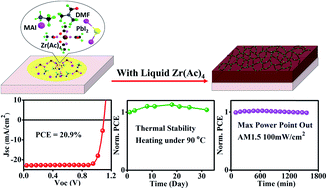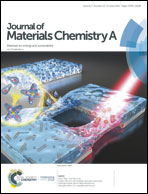Liquid metal acetate assisted preparation of high-efficiency and stable inverted perovskite solar cells†
Abstract
Defects in perovskite solar cells (PSCs) severely affect the efficiency and stability. The use of additives to passivate the defect states in perovskite films has proved feasible and effective. Metal acetates have been recognized as promising additives for PSCs and can passivate the trap states produced by undercoordinated ions and assist in film formation. In the fabrication process, additives are frequently used combined with dimethyl sulfoxide (DMSO) to regulate the optoelectronic properties and morphology of perovskite films. However, it has been reported that the stability of the devices may be affected by the introduction of DMSO due to its evaporation during film formation. The use of too many additives will complicate the fabrication process. Well-selected and suitable additives are still required to simplify the fabrication process and to improve the efficiency and the stability of PSCs. Here, we demonstrate that highly efficient and stable devices can be achieved by only using DMF as the solvent with liquid zirconium acetate (Zr(Ac)4) as the additive. The device with Zr(Ac)4 exhibits better film quality and lower defect states than that without Zr(Ac)4. A device with a structure of ITO/P3CT-N/MAPbI3/PC61BM/BCP/Ag achieves an efficiency of up to 20.9% with an optimum concentration of the dopant, maintains more than 98% of its initial performance after continuous max power point (MPP) output testing for 1700 minutes under a xenon lamp (AM1.5G, without a UV filter) and presents almost no decline after successive thermal heating at 90 °C for one month. Overall, this work presents the benign effects of regulating perovskite crystal growth and effectively passivating defects of perovskite films by the addition of liquid metal acetate.



 Please wait while we load your content...
Please wait while we load your content...